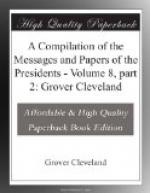[Footnote 32: A chain is made up of mountains whose bases touch each other.—BALBI.]
To this broken chain belongs the elevation of 918 feet given by Messrs. Mudge and Featherstonhaugh to an eminence in the neighborhood of the Aroostook Falls. An accurate profile of so many of these eminences as fall in the line of the connected meridian is herewith submitted. This chain of eminences is not prolonged to the westward, as it is entirely unconnected with any other height aspiring to the name of mountain in that direction.
It is not in any sense a dividing ridge, being cut by all the streams in the country, and in particular to a great depth by the St. John and the Aroostook.
A section of this line was given in a report to the British commissioner under the fifth article of the treaty of Ghent by Colonel Bouchette, the surveyor-general of the Province of Canada. His heights were determined by the barometer, and estimated from the assumed level of the monument at the source of the St. Croix.
It would now appear that the section of Colonel Bouchette is very inaccurate, and that the heights as reported by him are not only much beyond the truth, but that the continually ascending slope ascribed by him to the country from the monument at the source of the St. Croix to the point where the due north line crosses the St. John is entirely erroneous. He, however, adroitly availed himself of this inaccurate section to attempt to prove the existence of a continuous chain of mountains from Katahdin to the Great Falls of the St. John, and thence around the southwestern branches of the Restigouche until it met the heights rising from the north shore of the Bay of Chaleurs. For this reason his view taken from Park’s barn and that made by Mr. Odell from the same point were urged for admission as evidence on oath by the British agent, and the map of Mr. Johnson, which contradicted this evidence, was carefully excluded. It can not be concealed that could Colonel Bouchette’s idea founded on erroneous premises have been established by indisputable facts it would have been the most fatal argument that has ever been adduced against the American claim, for he would have argued that the meridian line of the St. Croix would at Mars Hill have first intersected highlands which, rising from the north shore of the Bay of Chaleurs, would have appeared to divide until within a few miles of the Grand Falls of the St. John waters which fall into the St. Lawrence from those which fall into the Atlantic, and would have been the south boundary of the Province of Quebec.




